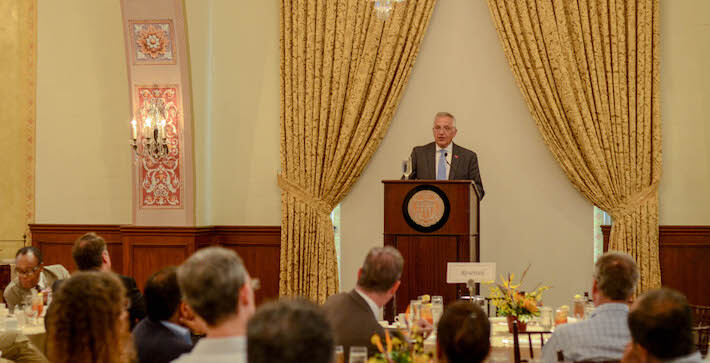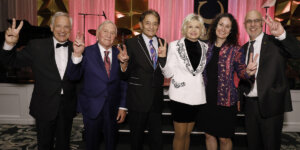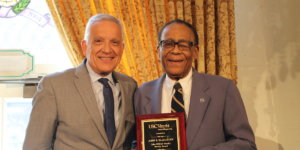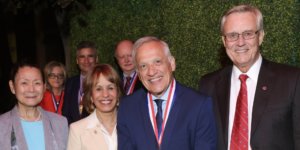
Dean Yannis Yortsos (photo/Peter Shin)
Dean Yannis Yortsos, in his Sept. 21, 2016 “State of the School” address, spoke to faculty and staff members at Town and Gown about the tremendous evolution of technology and how those advances have shaped USC Viterbi. Yortsos filtered these developments through the prism of “three ‘C’ words: convergence, connectedness and culture.”
The dean also announced the creation of several new centers – many of them interdisciplinary – that promise to address problems ranging from homelessness to improving education. Yortsos announced a new center on machine learning, MaSCle, to be led by Yan Liu, associate professor of computer science; a center on cyber-physical systems and the Internet of Things (IoT), CCI, to be led by Bhaskar Krishnamachari, professor or electrical engineering; a new center on artificial intelligence for social good, CAIS, to be led by Milind Tambe, professor of computer science, and run in partnership with the USC Suzanne Dworak-Peck School of Social Work; and CHARIOT, a new USC Viterbi-USC Rossier School of Education collaboration to apply IoT to personalized learning.
Additionally, Dean Yortsos spoke about changing the conversation about engineering, addressing what engineers do, who they are, and what they look like. He stressed the relevance of the NAE Grand Challenges and the Grand Challenges Scholars Program, as redefining engineering, and commented on the importance of diversity and inclusion. He particularly hailed a diversity initiative that he helped lead nationally, which to date has been signed by more than 175 deans across the country.
At the beginning of his speech, the dean asked for a moment of silence in memory of the recent passing of three USC Viterbi titans: Sol Golomb a world-renowned electrical engineer who spent a half century here; Steven Sample, USC’s visionary 10th president and an electrical engineer; and Si Ramo, a brilliant engineer and USC Viterbi Presidential Chair who helped build TRW, and later, Northrop Grumman.
On Sol Golomb’s meaning to USC Viterbi
“For over 50 amazing years, Sol devoted his professional life to USC Engineering. He joined USC, instead of Caltech or Harvard, from both places of which he had an offer, because he thought he would make a bigger difference. As with everything else Golomb-related, he could not have been more right. In a most fundamental way, through his radiating brilliance, Sol left a monumental legacy at USC Viterbi. He attracted, mentored and promoted talented colleagues. And in the process he created a culture of service and a culture of excellence that continues today. It is unlikely there would have been an Andrew Viterbi at USC without Sol Golomb. Or Bill Lindsey. Or Lloyd Welch. The list is long. He will be missed more than we can imagine.”
On convergence
“Convergence occurs when engineering empowers or co-mingles with other disciplines for useful purposes. This is the first “C” word in today’s speech. Convergence is another word for Engineering + X, where X is (truly) anything — e.g. media, medicine, entertainment, biology, education. And I see this convergence following one of three different pathways: We will call them E2X, EUX and X2E.
The first path, E2X, is where E (engineering) makes X smarter, more efficient. It helps open new opportunities, and to acquire new dimensions and properties, many of which are disruptive. Consider the digitization of wide swaths of our economy and their truly transformative global impact. Digital media, communications, entertainment, platforms. This is E2X. It is the ubiquitous digitization of almost everything. The incoming torrent of cyber-physical disruption with the Internet of Things (IoT) and other fast rising cyber-physical technologies and systems is also E2X.”
On EUX, a “second convergence path”
“This is where engineering and X comingle in a tight tango dance, a tightly intertwined “double helix” of mostly natural sciences and engineering. EUX is the path where convergence can lead to truly exponential technologies.
Consider engineering plus biology, a partnership with the USC Dornsife College at the rapidly constructed new Michelson Center. Consider engineering plus quantum physics, and engineering plus medicine, a partnership with the Keck School of Medicine reflected in the works of Mark Humayun on artificial retina, and of biomedical engineering Professor Ted Berger on memory prosthetics. And so on.”
On X2E
“This brings us to the third path, X2E, where E can benefit from X — e.g. in biomimetic or socio-mimetic contexts. In certain X-mimetic processes, X2E is really the shortcut for optimal answers to complex problems that nature has uncovered, through “nature’s” optimization, practiced over the millions years of evolution. Paul Bogdan of electrical engineering researches ants, pigeons and bacteria to develop a series of algorithms that can actually quantify the degree of complexity within swarms. These algorithms could potentially contribute to the design of collaborative robots, improving their performance by helping them adapt, operate and evolve as part of a group. Nature improving engineering design.
Again, interesting, novel questions arise when X represents a discipline or process dominated not by logic or the natural sciences, but rather by social sciences, by emotions, or by legal or ethical considerations or by character. What are the E2X, EUX and X2E pathways then?
Engineering +, Convergence are the most promising ways for solving the Grand Challenges of our times. We are all familiar with the NAE Grand Challenges, for example in sustainability, health, security and the joy of living, which this school has championed from the very beginning. But they are also important for the solution of X-type grand challenges (such as the recently articulated Social Work Grand Challenges, inspired by the NAE Grand Challenges here at USC).”
On connectedness
“Connectedness is the second “C” word. We live in the era where everything and everyone is – or will be – connected to everything and everyone. For an engineering school in particular, this provides vast opportunities to revolutionize the way we interact, teach, research, and manage. The wonderful recent book, “The Platform Revolution,” compellingly argues that platforms, powered by engineering and connectivity, are revolutionizing those businesses where information is the commodity being exchanged. Consider Uber, Amazon, Google, Apple and Facebook. Platforms have appended and permanently disrupted the traditional linear pipeline business models. Empowered by digital technology and sophisticated software platform tools, these enable value-creating frictionless interactions between distributed producers and consumers.”
On culture
“We are in the business of higher education, a non-profit endeavor, for one and one only reason: to serve our constituencies (in a wide interpretation). This culture that serves, seamlessly and frictionlessly, students, faculty, staff, alumni, parents, the corporate world, academia and all our friends should be treasured. And should be enhanced.
We believe that Engineering empowers the world. This enabling Changes the Conversation about engineering. Consider the NAE Grand Challenges, a set of aspirational goals. It is not about a new formula. It is about how to solve problems that have great societal impact. It is about convergence. Changing the conversation along these lines is most important to position our discipline in the most fundamental position in today’s world. And to help change the face of engineering, by attracting a truly wonderful and diverse group of faculty and students. We already see the great effect of such messaging in our own students: this year, the fraction of women in our freshman class is 40 percent, the highest ever in our history- not to mention that it is the brightest in our history, with a 19 SAT points increase. Increased excellence through increased women participation in engineering. Could one really do any better?
We are changing the conversation about engineering, of what engineers do, who they are and what they look like. Our amazing female faculty members prove that every day. Consider: The ‘MIT Technology Review’ recently named Kelly Sanders and Nora Ayanian to its prestigious TR-35 list as two of the world’s leading innovators under the age of 35. In the last 7 years, 12 faculty of USC Viterbi were chosen in that list- of which eight (3/4ths) have been women. Incidentally, USC Viterbi is likely among the top two or three institutions worldwide with as many such distinctions.”
On the quality of new students
“Just like last year, and the year before, and the year before, our freshman class is the best in its history. The first derivative is positive! Here are a few numbers that might interest you:
The entering class of about 420 is one of the most selective ever- with more than 12,000 applications received. 163 students in our entering class are University Scholars; 56 are National Merit Scholars. The average SAT at USC Viterbi has increased by almost 100 points in the last 10 years. Nearly 40 percent of the entering freshmen are women — an amazing statistic, making the overall Viterbi women average to more than one-third women. Our students come from 20 different countries; 41 different states; and have incredibly diverse backgrounds and interests.”
On the Grand Challenges Scholars Program (GCSP)
Developing skills outside the curriculum is a key and important part of the student’s experience. A number of engineering schools nationwide have adapted a new model of engineering education for a select number of undergraduate students, the Grand Challenges Scholars Program (GCSP). GCSP involves five components, in addition to the traditional engineering curriculum:
1. Research or a hands-on project on a topic related to the NAE Grand Challenges.
2. Interdisciplinary curriculum and mentoring.
3. Engagement in an innovation and entrepreneurship venture.
4. Global context and experience.
5. Service learning through outreach to the community and/or social entrepreneurship.
This program is robust and growing at USC Viterbi, where it was co-conceived in 2009 together with our former USC colleagues Rick Miller, President of Olin College and Tom Katsouleas, then dean of engineering at Duke University. I am very proud to say that I will be organizing and chairing the first ever GCSP Summit at the NAS Building in DC on October 7, followed by a session at the Office of Science and Technology Policy of the White House in the afternoon.
On USC Viterbi’s graduate programs
Our graduate programs are as robust as ever. We again hit an all- time high of more than14,000 applications both for our DEN@Viterbi and on-campus program, making this Fall’s graduate classes the most selective in USC Viterbi’s history.
On outreach to the military
“One of the strategic priorities of the university is engagement with active military and veterans. Through GAPP (Office of Graduate and Professional Programs), we have made this a top priority. Some examples:
• Over 85 active military and veterans are now enrolled in our graduate programs, mostly through DEN.
• Through a strategic partnership with the Pentagon, we have now five mid-career officers in our M.S. and Ph.D. programs.
• In October, we will launch a training program for the U.S. Army’s Cyber Command in the area of data informatics.
• And most exciting of all, we have introduced a program to provide to an unlimited number of partial scholarships to veterans admitted to our M.S. programs and on the GI Bill through the Yellow Ribbon program.”
On the Department of Computer Science and new faculty
“Even though most rankings are not to be trusted, I cannot but single out the Department of Computer Science, which was ranked 9th in the world by Microsoft’s academic research rankings, with the AI program ranked 4th. Hao Li, assistant professor of computer science, was singled out as the best computer graphics person in the world. Not much better than this distinction.”
On new faculty
“In the past faculty recruitment cycle, we hired 13 new tenure-track faculty, of whom four are women and two Hispanic. The tenure-track pool comprised nearly 2,500 applicants.”
On a new computer science building
“With a goal of providing our students and faculty with the best facilities found anywhere, I am pleased to announce that the university has approved the start of a fundraising effort for a new computer science building to be located between Kaprielian Hall and the USC Michelson Center for Convergent Bioscience. Such a building will provide the physical environment to support research, teaching and collaborative spaces for our CS students and faculty. The expected $90-million facility would consolidate all computer science programs, classrooms and research spaces. A naming gift of $50 million will start construction.”
On innovation
“We are also changing the conversation about innovation. We are nurturing the growth of an ecosystem of innovation that I like to call SCilicon Beach. That’s with an “SC.” With two of our research powerhouses — the Information Sciences Institute and the Institute for Creative Technologies — located in the heart of Silicon Beach, we are greatly positioned to be the premier private research university driving technology innovation in Southern California.
SCilicon Beach has the potential to dismantle stereotypes and change the conversation on tech entrepreneurship by including the entire vibrant spectrum of ethnically and culturally diverse talent in Southern California.”
On Fundraising
“Our fundraising goal set in 2010 was to raise $500 million by 2018. This follows a successful $300 million campaign completed in 2008. In the broadest sense, we will invest our donors’ gifts to support the four pillars by attracting world-class professors and students; endowing chairs; providing student scholarships, creating new programs; naming and endowing departments and programs; and building best-in-class facilities to advance research and our commitment to innovation and entrepreneurship.
To date, we have raised very close to $400 million, about 80 percent of the way to our goal. More than 12,300 unique donors have given so far in this campaign, led by Mary Ann Schwartz, our Senior Associate Dean of Advancement, and her Advancement team. Among the most recent gifts I am pleased to announce two endowed chairs, one for a professorship and the other for an Early Career. A memo will come out shortly. Last year, in particular, was the best fundraising year in our history, with cash and pledges exceeding $100 million. We are hoping for two more years of strong performance, which will be needed to close our goal.”
Final thoughts
“As I close, I am reminded of the book, The Beginning of Infinity, by Oxford quantum physicist David Deutsch. He states:
1) Problems (I prefer to say, challenges) are inevitable.
2) But all problems are solvable.
Indeed, there will always be problems, because they represent collisions of ideas and because as you move ahead, the challenges become greater. But I absolutely share in the belief that all problems are solvable. I invite you to share this mindset and add to your vocabulary this other word- solvable- starting with the letter S.”
Published on September 26th, 2016
Last updated on May 22nd, 2021











